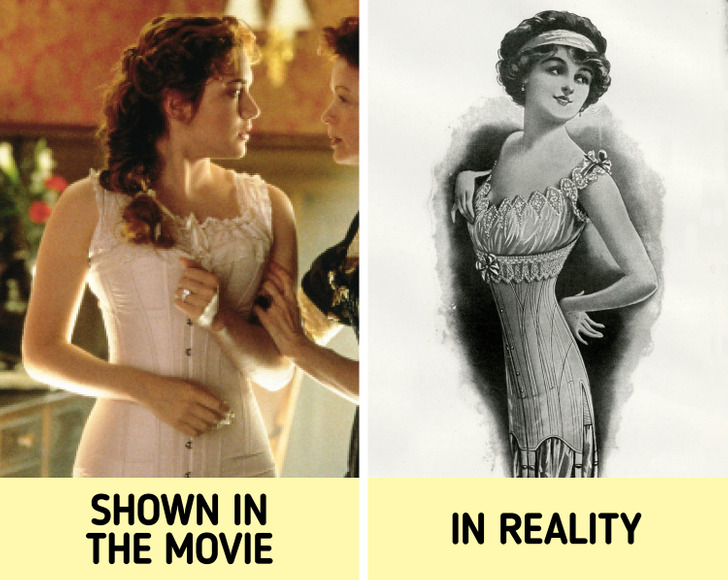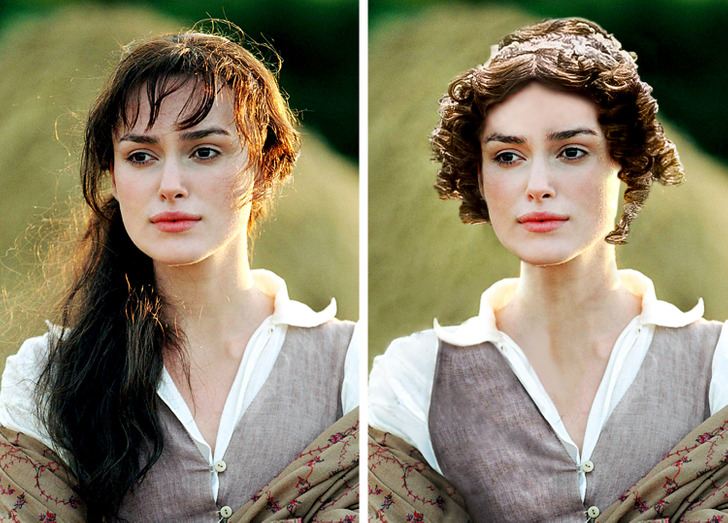13 Times Movie-Makers Were Not Accurate With Historical Costumes, Yet We Believed Them

Dozens of different specialists develop the style of a movie character, and they make sure that the costumes correspond to a certain historical era. But still, they can’t always avoid some mistakes. Even professionals make them. But sometimes creators turn a blind eye to little blunders for the sake of artistic expression.
Titanic
This film is set in the Edwardian era. In one scene, we see Rose’s mother diligently lacing her daughter’s corset. However, the item shown in the movie doesn’t correspond to the era. The model the heroin wears fully covers her chest and has a curved bustline. At the beginning of the last century, a lush natural breast was considered beautiful, and to emphasize the shape, women of fashion wore long corsets with a straight low bustline.
Little Women
It’s almost impossible to imagine a girl of the Victorian era without a bonnet. However, in the latest screen adaptation of Louisa May Alcott’s novel Little Women, costume designers decided to get rid of this accessory, replacing it with straw hats or completely depriving the heroines of any headdresses.
Elizabeth: The Golden Age
In the movie Elizabeth: The Golden Age, Clive Owen, who portrays Sir Walter Raleigh, never takes off his leather boots, and even goes to see the Queen in them. However, the real Walter Raleigh would hardly have thought of wearing boots intended for hunting and riding in the presence of the Queen. The wardrobe of medieval nobles was much more varied than what we usually see in the movies. And most of the time the court nobility wore elegant leather shoes and hosiery.
Moulin Rouge!
Nicole Kidman in the musical film Moulin Rouge! is magnificent without any doubt. But, unfortunately, almost none of her costumes correspond to reality. The costume of the famous Parisian cabaret dancers actually consisted of fluffy can-can skirts and voluminous white pantaloons. And their legs were covered with black thick stockings, not fishnet tights.
The Tudors
In almost all movies where the action takes place in the Middle Ages, heroines flaunt beautiful corsets with bare shoulders, and The Tudors is no exception. However, the reality was less romantic. In the 16th century, no noble lady could do without an undergarment. Smocks and shifts made of linen, cotton, and sometimes silk, protected them from the cold and prevented chafing from wearing rigid corsets. Besides, washing a linen smock was much easier than washing gowns made of expensive fabrics.
The Spanish Princess
The costume designers included many mistakes in the TV series The Spanish Princess. The main character, Catherine of Aragon, usually wears the Spanish style of royal dress. But sometimes it is quite difficult to identify the origins of these designs. For example, this dress could not exist in 16th century. The skirt looks a bit weird, and it is too short, as viewers can see the princess’s ankles. In that time, such kind of outfit would have been considered inappropriate.
Grease
The iconic musical film Grease is set in 1958, but in one of the key scenes, Sandy appears wearing a wild hairstyle which is more relevant to the 1970s.
Her black shiny leggings don’t correspond to the fashion of those times either. They were not only too tight but apparently were made of Spandex which wasn’t patented until 1959.
Enola Holmes
Most of Enola Holmes’ costumes are made with perfect precision, but there are still some mistakes. So, the elements of some outfits, in particular the bodice of the burgundy dress and the skirt of the pink dress, emulate more 1870s fashion than the fashion of the 1880s, when the action takes place. In addition, the neckline on the burgundy dress is too revealing: a young girl of those years would hardly have dared to walk around in a similar dress on the street in the daytime.
Kingdom of Heaven
Even though Balian, played by Orlando Bloom, was a courageous man, he would hardly dare to come out to a battlefield without wearing a helmet.
My Fair Lady
The most popular hairstyle of the beginning of the 20th century (the action of the movie takes place in 1912) was the softly swirled pompadour style. This hairstyle was worn to support wide-brimmed hats, which were fashionable in those years. But the high hairstyle, that Audrey Hepburn wore in the movie, was out of the question for the time.
Pride & Prejudice
The action of the movie and the novel takes place from 1811-1812 when natural curls replaced pompous wigs. The girls put up their hair into a high bun, and the main beautiful element of their hairstyle were tight curls around the forehead and temples. And of course, they didn’t wear loose hair and bangs.
Emma
Emma, played by Gwyneth Paltrow, also didn’t wear any headwear. Throughout the movie, the heroine repeatedly appears in the open air with her head uncovered, which was simply unthinkable for those years. In the 1810s, every respectable lady had a collection of bonnets and caps that protected her from the sun and bad weather and also signified her status.
Bonus
Until the 20th century, the beauty ideal was a voluptuous female body with curves. This trend can be seen in the works of art and especially on the canvases of famous artists of that period. Renaissance artists, impressionists, and even cubists praised curvaceous women. And it seems that the actresses embodying the main beauties of the 18th-19th centuries on the screen should also meet these standards.
However, we often see modern beauty icons with sunken cheeks and expressive cheekbones in historical movies. A striking example of this is charming Keira Knightley. The actress is very far from the beauty ideals of those years, but nevertheless, viewers love her work.
Do you pay attention to mistakes like this in movies? What do you think about them? Tell us in the comments below.














